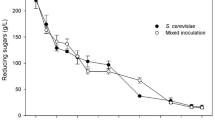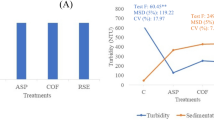Abstract
Commercial starters were used in this study in combination with mineral salt with a low sodium chloride content for fermentation of white cabbage into sauerkraut, from which sauerkraut juice was pressed. The mineral salt used contained 57% sodium chloride and 28% potassium chloride. The sodium chloride content in the sliced white cabbage was 0.5% w/w. Lactic acid bacteria strains were used in various combinations. During the fermentation process, the pH was measured and the number of lactic acid bacteria was enumerated. Yeasts and moulds, enterobacteria as well as mesophilic and thermophilic spores were enumerated. The pH decreased rapidly in the beginning of the fermentations, ensuring an accurate start of the process. The fermentation process could be controlled and the end products were of good and uniform quality. The sensory quality of the juices was evaluated by using a taste panel and the juices were found to be highly acceptable. The use of mineral salt in combination with Leuconostoc mesenteroides resulted in an especially mild tasting sauerkraut juice with good sensory and microbiological quality.





Similar content being viewed by others
References
Eklund T (1989) In: Gould GW (ed) Mechanisms of action of food preservation procedures. Elsevier, London, pp 161–199
Adams MR, Hall CJ (1988) Growth inhibition of food-borne pathogens by lactic and acetic acids and their mixtures. Int J Food Sci Technol 23:287–292
Pederson CS, Albury MN (1969) The Sauerkraut Fermentation. NY Agric Exp Station Tech Bull 824
Hammes WP (1990) Bacterial starter cultures in food production. Food Biotechnol 4(1):383–397
Buckenhüskes HJ (1993) Selection criteria for lactic acid bacteria to be used as starter cultures for various food commodities. FEMS Microbiol Rev 12:253–272
Daeschel MA, Andersson RE, Fleming HP (1987) Microbial ecology of fermenting plant materials. FEMS Microbiology Reviews 46:357–367
Lücke F-K, Brümmer J-M, Buckenhüskes HJ, Garrido Fernandez A, Rodrigo M, Smith JE (1990) Starter culture development. In: Zeuthen P, Cheftel JC, Eriksson C, Gormley TR, Linko P, Paulus K (eds) Processing and quality of foods. Vol. 2: Food biotechnology: avenues to healthy and nutritious products, Elsevier Applied Science, London
Buckenhüskes HJ (1992) Advances in vegetable fermentation. Les Bactéries Lactiques. Actes du Colloque LACTIC 91. Adria Normandie. Centre de Publication de I’Université de Caen, France
Daeschel MA, Fleming HP (1984) Selection of lactic acid bacteria for use in vegetable fermentations. Food Microbiol 1(4):303–313
Frank HK (1973) Starterkulturen in der Lebensmitteltechnik. Chem Mikrobiol Technol Lebensmittel 2(2):52–56
Fleming HP, McFeeters RF, Daeschel MA (1985) In: Gilliland SE (ed) Bacterial starter cultures for foods. Academic, New York, pp 97–124
Buckenhüskes H, Schneider M, Hammes WP (1986) Die milchsaure Vergaerung pflanzlicher Rohware unter besonderer Beruecksichtigung der Herstellung von Sauerkraut. Chemie Mikrobiol Technol Lebensmittel 10:42–53
Delclos M (1992) Vegetable preservation by a mixed organic acid fermentation. Dissertation Abstr Int B 52(9):4537
Harris LJ, Fleming HP, Klaenhammer TR (1992) Novel paired starter culture system for sauerkraut, consisting of a nisin-resistant Leuconostoc mesenteroides strain and a nisin-producing Lactococcus lactis strain. Appl Environ Microbiol 58(5):1484–1489
Breidt F, Crowley KA, Fleming HP (1993) Isolation and characterization of nisin-resistant Leuconostoc mesenteroides for use in cabbage fermentations. Appl Environ Microbiol 59(11):3778–3783
Breidt F, Crowley KA, Fleming HP (1995) Controlling cabbage fermentations with nisin and nisin-resistant Leuconostoc mesenteroides. Food Microbiol 12(2):109–116
Halasz A, Barath A, Holzapfel WH (1999) The influence of starter culture selection on sauerkraut fermentation. Eur Food Res Technol 208:434–438
Hammes WP (1991) Fermentation of non-dairy foods. Food Biotechnol 5(3):293–303
Desai P, Sheth T (1997) Controlled fermentation of vegetables using mixed inoculum of lactic cultures. J Food Sci Technol 34(2):155–158
Viander B, Mäki M, Palva A (2003) Impact of low salt concentration, salt quality on natural large-scale sauerkraut fermentation. Food Microbiol 20:391–395
Tuorila H, Hellemann U (1993) Elintarvikkeet aistien puntarissa (Sensory evaluation of foods). Yliopistopaino, Helsingin yliopisto, Helsinki, pp 37, 39
Neish AC (1952) Analytical methods for bacterial fermentations. Nat Res Counc Can Bull 46(8):3
Pederson CS, Albury MN (1961) The effect of pure culture inoculation on fermentation of cucumbers. Food Technol 15:351–354
Pederson CS (1940) The relation between quality and chemical composition of canned sauerkraut. NY State Agric Exp Station Bull 693:1–15
Fleming HP, McFeeters RF (1985) Residual sugars and fermentation products in raw and finished commercial sauerkraut. NY State Agric Exp Station Special Rep 56:25–29
Trail AC, Fleming HP, Young CT, McFeeters RF (1996) Chemical and sensory characterization of commercial sauerkraut. J Food Qual 19:15–30
Anon. (1925) Sauerkraut. US Dept Agric. Food Insp. Decis., 196, 1. US Department of Agriculture, Washington, DC
Acknowledgements
The authors are grateful to Hannu Korhonen for his valuable comments during the preparation of this manuscript. Furthermore, the authors are thankful to Pirjo Satka for excellent technical assistance and Heli Vähä-Touru for skilful assistance in drawing the graphics. The authors also wish to thank Arktinen Bio-Lacto Oy for participating in this study.
Author information
Authors and Affiliations
Corresponding author
Rights and permissions
About this article
Cite this article
Wiander, B., Ryhänen, EL. Laboratory and large-scale fermentation of white cabbage into sauerkraut and sauerkraut juice by using starters in combination with mineral salt with a low NaCl content. Eur Food Res Technol 220, 191–195 (2005). https://doi.org/10.1007/s00217-004-1080-5
Received:
Published:
Issue Date:
DOI: https://doi.org/10.1007/s00217-004-1080-5




